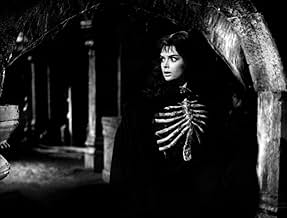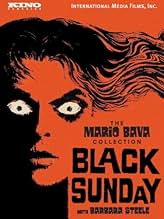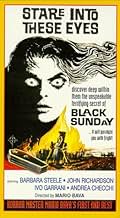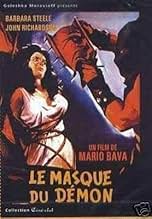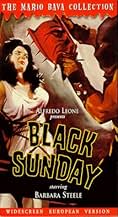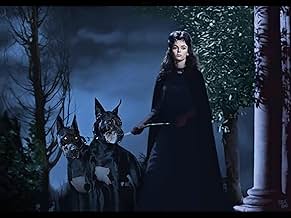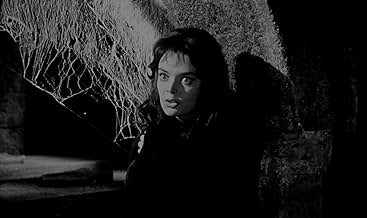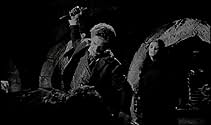Une sorcière vengeuse et son servant diabolique reviennent d'entre les morts et se lancent dans une campagne sanglante visant à posséder le corps de la magnifique descendante de la sorcière,... Tout lireUne sorcière vengeuse et son servant diabolique reviennent d'entre les morts et se lancent dans une campagne sanglante visant à posséder le corps de la magnifique descendante de la sorcière, avec pour seul obstacle son frère et un docteur.Une sorcière vengeuse et son servant diabolique reviennent d'entre les morts et se lancent dans une campagne sanglante visant à posséder le corps de la magnifique descendante de la sorcière, avec pour seul obstacle son frère et un docteur.
- Prix
- 1 victoire et 1 nomination au total
- Princess Asa Vajda
- (as Barbara Steel)
- …
- Priest
- (uncredited)
- Crucifixion Torturer
- (uncredited)
- Tavern Girl
- (uncredited)
- Tavern Keeper
- (uncredited)
- Narrator
- (voice)
- (uncredited)
- Spectator
- (uncredited)
Avis en vedette
The opening scene of the execution of Asa is a stunning combination of atmosphere and violent imagery. The Mask of Satan(1960) is based on a short story by Nikolai Gogol. Gogol is a writer that would play together with Edgar Allen Poe as a major influence in Bava's Supernatural tales. Its one of the best horror films of the last fifty years. Asa is resurrected when the blood of a doctor is accidently dropped on her corpse(this is played homage to in Lamberto Bava's Demons 2{1986}). Tim Burton has cited this movie as one of his favorites.
The film was pratically butchered in the states when first released, but has since been released on Home Video in uncut form(longest print in existence). This is an item that many aspiring Horror Filmmakers should watch in order to see how a great horror film should be done. The Mask of Satan(1960) isn't interested in plot and story as much as atmosphere and painting style visuals. Barbara Steele emerges as the first horror queen of the modern era. Barbara Steele has a macabre beauty that bewitches the viewer and gives her presence. Barbara Steele along with Christopher Lee, Peter Cushing, and Vincent Price were some of the greatest icons in 1960's-1970's horror films.
Barbara Steele does outstanding work as the witch Asa and her descendent Katia. Mario Bava's direction has the look of a great artist. Bava also contributes to the great cinematography. La Maschera Del Demonio is a well made mixture of the Universal Horror features of the 30's-40's and the violence of Hammer Horror of the 50's-60's. The fact that Mario Bava did this based on the success of Horror of Dracula(1958) must have influenced Terence Fisher to respond by directing Dracula:Prince of Darkness(1965). One theme that is present in The Mask of Satan(1960) is the decay and decline of a once happy and powerful family(more fully explored in Bava's later films of Black Sabbath{1963}, The Whip & the Body{1964}, Lisa and the Devil{1974}, and Shock{1977}).
Mario Bava's first feature as a director (although he did uncredited directorial work before), this classic and extremely influential piece of Gothic horror really showed his cinematographic talent in creating a haunting and stylishly shot film. "Black Sunday" also catapulted Barbara Steele to horror stardom and would make her into the undisputed horror queen of the sixties. Bava based "Mask of Satan", as the film was originally titled, on the short story "Vij" by the Russian author Gogol, which he adapted into a homage to the early Universal horror pictures he loved so much. Barbara Steele is the beautiful 17th century witch princess Asa, who is a vampire, and her lover Juvato (Arturo Dominici), are put to death by her vengeful brother. He has iron masks with spikes on the inside placed on both their faces and then sledgehammered home (the brutal opening scene). Two hundred years later, blood is accidentally spilled on Asa's face and she rises from the dead along with Juvato to wreak revenge on the descendants of those who executed her - including her look-alike Katia, also played by Barbara Steele.
Beautifully shot in black and white by Bava himself, "Black Sunday" is a perfect showcase of his masterful control of light and shade, of colour and movement (yes, one can play with "shades of colour" in black and white) and playful camera angles, it's a feast for the eye. At heart Bava would always remain the cinematographer he always was and in all his films he took an active role in the design of each image by setting up the lighting, the optical effects, the filters etc. The film abounds in old-fashioned horror atmosphere and in that department, it even manages to top the atmosphere of the Universal horror classics it was based on with gnarled tree branches, fogbound sets, a decaying castle, a dark foreboding crypt and much more.
Of course, Bava's is well known for letting stylistic innovations take precedent over storytelling and most other things involved, like acting. Much of the script was reworked during shooting and even in post-production. Barbara Steele reportedly never even saw a script and got some pages every day of shooting. Variations of the story has been told many times in one way or another and there are more than a few echoes of Murnau's Nosferatu here. Much of the story is too derivative to begin with, and has become too formularised in subsequent years to retain much of its original power, just as the film's capacity to scare or excite audiences has probably worn out a little over the years. It doesn't really matter, because the film was chopped to pieces for over four decades and the habit of Italian filmmakers of post-synchronizing all the voices (even for Italian versions) made anything in that department a pretty dire affair anyway.
What Bava added however was some substantially more explicit violence and gore, laced with sexual connotations. The opening scene in which the mask is sledgehammered to Barbara Steele's face still packs quite a wallop, not to mention the effect it must have had on audiences back then. Still, horror fans can't really afford to miss this quintessential Bava piece, but watch it for the splendid cinematography and Bava's unique ways of visual wizardry.
Camera Obscura --- 7/10
Even though this movie is best appreciated as an exercise in style and technique, the plot line (witch who is executed and returns centuries later to get revenge on the descendants of her executioners) is also enjoyable. So is Barbara Steele, who is ideally cast in a dual role as both the evil witch and the pure heroine. She's an actress who can switch from innocent and ravishing to hideous and horrific with the flick of an eyelash. No wonder she's considered the queen of horror. She deserves to be.
And however,Bava's film is a sparkling diamond.How come?The direction of course,the cinematography absolutely incredibly breath-taking,and Barbara Steele ,the par excellence Gothic heroine:her fans will rejoice for she plays two parts here! Bava has no match when it comes to use the light the settings and the soundtrack.It's a black and white work and had it been filmed in color it would not have been better.From the gloomy family vaults to the forest where danger awaits on the young peasant girl to the doomed castle where a family tries to fight against a mysterious curse.
The carriage which takes the doctor to the mansion and its coachman reminds me of Murnau's "Nosferatu" .No less.
Le saviez-vous
- AnecdotesMario Bava and Barbara Steele had a difficult working relationship. She sometimes refused to come to set because she did not like her wig or the fact that her cleavage would be shown. One time she refused because she believed Bava would force her to appear nude. She admits that she was difficult due to her inexperience and inability to understand Italian.
- GaffesIn the opening credits, Barbara Steele's name is misspelled as Barbara Steel.
- Citations
Princess Asa Vajda: You, too, can feel the joy and happiness of hating.
- Générique farfeluFor "The Mask of Satan," the English language version prepared in Italy, Barbara Steele's name is listed as "Barbara Steel" on the trailer and on the credits of the film itself.
- Autres versionsThe full list of differences between the 83-minute original cut and the 80-minute AIP cut:
- A different English-language dub, and a new score by Les Baxter.
- An added pre-text crawl warning the audience about the film's content: "The producers of the picture you are about to see feel a moral obligation to warn you that it will shock you as no other film ever has. Because it could be very harmful to young and impressionable minds, it is restricted to only those over fourteen years of age."
- Alternate opening credits.
- A brief exchange between Katja and Constantine where he tells her their father has died is cut.
- A scene where Katja and Andrej talk in the garden is cut.
- An exchange between Katja and Andrej outside her room is cut.
- Kruvajan's death scene is cut down significantly to remove shots of his eye spurting blood.
- The scene were Prince Vajda reanimates and menaces Katja is trimmed.
- Vajda's death scene, particularly the close-ups of his head melting, is trimmed.
- Asa taunting Andrej before being burned at the stake is cut.
- Added closing credits.
- ConnexionsFeatured in I motorizzati (1962)
Meilleurs choix
Détails
- Durée1 heure 27 minutes
- Couleur
- Mixage
- Rapport de forme
- 1.66 : 1
Contribuer à cette page



